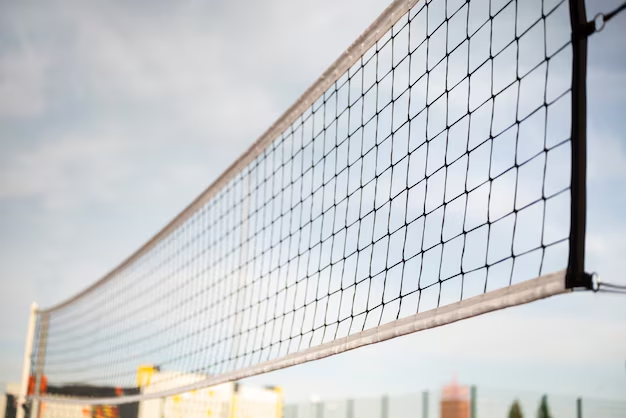Volleyball being a fast-paced, high-energy sport that relies on precision, teamwork, and strategy. While many players focus on their skills such as spiking, setting, and blocking, the volleyball net itself plays a crucial role in the game’s dynamics. The net’s size and height directly affect the style of play, the difficulty of certain moves, and even the overall competitiveness of a match. But have you ever wondered why the net is set at a specific height? Or why different categories of players; men, women, and juniors, have different net measurements? This blog post will break down volleyball net size, height, and how they shape the game.
Standard Volleyball Net Size and Dimensions
A volleyball net is more than just a barrier separating two teams; it serves as the defining factor in how the game is played. The standard volleyball net size follows official regulations set by governing bodies like the Fédération Internationale de Volleyball (FIVB) and the National Collegiate Athletic Association (NCAA).
Official Net Dimensions
The net is designed with precise measurements to maintain consistency in the game. Here are the standard dimensions:
Width: 9.5 to 10 meters (31.2 to 32.8 feet)
Height: It varies depending on the category of play (men’s, women’s, and junior volleyball)
Mesh Size: The openings in the net are small enough to prevent the ball from passing through (approximately 10 cm or 4 inches square)
Side Bands: Two vertical white bands, each about 5 cm (2 inches) wide, are attached on the sides of the net
Antennae: Two flexible rods, each 1.8 meters (5.9 feet) tall, extend above the net to indicate the playing area
Why the Net Dimensions Matter
The net size is carefully designed to ensure fairness and consistency across matches. A net that is too wide or too narrow would alter the court dynamics, giving an advantage to certain playing styles. Similarly, the mesh size prevents the ball from slipping through, ensuring proper volleys and blocking opportunities. The white side bands and antennae also help referees and players judge whether the ball is legally in play.
Volleyball Net Height (The Standard Measurements)
The height of the volleyball net is a critical factor that affects how the game is played. Volleyball governing bodies have established specific net heights to accommodate different levels of competition and player abilities.
Men’s Volleyball Net Height
Standard Height: 2.43 meters (7 feet 11 5/8 inches)
Used in: Professional men’s leagues, college volleyball, and high school varsity teams
Why this height? This height allows for competitive play while accounting for the average height and jumping ability of male athletes.
Women’s Volleyball Net Height
Standard Height: 2.24 meters (7 feet 4 1/8 inches)
Used in: Women’s professional leagues, college volleyball, and high school varsity teams
Why lower than men’s? On average, female players have different physical attributes, and this net height helps maintain balance in play styles.
Junior Volleyball Net Heights
For younger players, the net is set at lower heights to match their developing skills and physical abilities. The standard heights are:
Boys aged 14 and under: 2.24 meters (7 feet 4 1/8 inches)
Girls aged 14 and under: 2.13 meters (7 feet)
Coed and younger players: 1.98 meters (6 feet 6 inches)
Sitting Volleyball Net Height for Paralympic
For sitting volleyball, a Paralympic sport, the net height is much lower to allow play from a seated position:
Men’s Sitting Volleyball: 1.15 meters (3 feet 9.3 inches)
Women’s Sitting Volleyball: 1.05 meters (3 feet 5.3 inches)
How Net Height Affects the Game
The height of the net directly influences the pace and strategy of volleyball. The interaction between players, the ball, and the net determines the game’s complexity and excitement.
Blocking and Attacking
In men’s volleyball, the higher net height makes blocking and spiking more challenging, favoring taller players with greater vertical reach. Conversely, women’s volleyball, with a slightly lower net, allows for more exciting rallies and creative plays.
Serving and Passing
A higher net means jump serves must be more powerful and precise, while a lower net allows for more float serves and tactical placements. For junior players, the lower net height helps them develop proper technique without excessive strain.
Defensive Play
With different net heights, defensive strategies adjust accordingly. In men’s volleyball, blockers must reach higher, and defenders anticipate stronger spikes. In women’s volleyball, the slightly lower net encourages a mix of power and finesse in attacks.
Changes in Volleyball Net Standards Over Time
Volleyball has gone through several adjustments since its invention in 1895 by William G. Morgan. Initially, the net height was set at 6 feet 6 inches, as the sport was designed as a less intense alternative to basketball. Over the years, as volleyball became more competitive, net heights were adjusted to match the increasing athleticism of players.
Volleyball governing bodies have regularly reviewed and refined regulations to keep the game fair and exciting. Today, modern technology plays a role in maintaining net consistency, with advanced equipment ensuring precision in net height and stability.
Choosing the Right Net for Different Venues
Volleyball is played in various settings, from professional courts to recreational beaches. The type of net used depends on the playing environment.
Indoor Volleyball Nets
Tightly strung with steel cables for stability
Regulation height poles with adjustable tension settings
Side bands and antennae included for professional play
Usually made from high-quality nylon for durability
Beach Volleyball Nets
Slightly looser tension to accommodate wind and sand movement
Height slightly adjusted (Men: 2.43m, Women: 2.24m) but with flexibility depending on conditions
Made of weather-resistant materials to withstand outdoor elements
Often include boundary lines and anchor systems for sand courts
Backyard and Recreational Nets
Adjustable heights for different skill levels
Portable and lightweight for easy setup
Made of durable synthetic materials for longevity
Commonly used for casual play and family gatherings
How to Maintain a Volleyball Net
Proper maintenance ensures that a volleyball net remains functional and durable over time. Some ways to maintain volleyball net include;
Regular Inspections: Check for frayed netting, loose cables, or damaged poles.
Cleaning: Wipe down the net regularly, especially for outdoor setups exposed to dirt and moisture.
Proper Storage: When not in use, store the net in a dry place to prevent wear and tear.
Tension Adjustments: Ensure the net is neither too tight nor too loose, as incorrect tension can affect gameplay.
The volleyball net is more than just a dividing line on the court—it’s a crucial element that dictates the flow, style, and fairness of the game. Whether you’re playing at a professional level, enjoying a casual beach game, or introducing young athletes to the sport, understanding the net’s size and height can enhance both your appreciation and performance in volleyball.
Whenever you step visit the court, trying to play volleyball, take a moment to acknowledge the net, its height, tension, and positioning because every spike, block, and serve depends on it. After all, volleyball wouldn’t be the same without that perfectly placed net defining the challenge for both teams!
I hope that you’ve gotten to know everything about the volleyball net, why not share this article to your family and friends!




